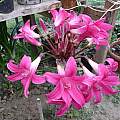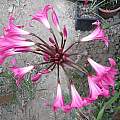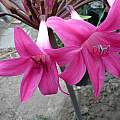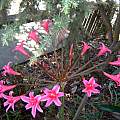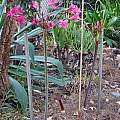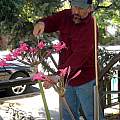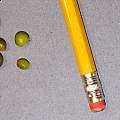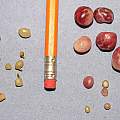×Amarygia is the name used for hybrids between species of Amaryllis and Brunsvigia. The flowers often resemble more of Amaryllis than Brunsvigia.
Various Amaryllis × Brunsvigia crosses have been made over the years, with varying results. The history of these crosses is complicated. If you want to learn more about them, here are a few references:
Seed produced by various ×Amarygia crosses
Use of the name ×Amarygia
Confusion between ×Amarygia and Amaryllis belladonna selections
History of ×Amarygia
The following is a cross between Amaryllis belladonna × Brunsvigia josephinae. Photos taken by Alessandro Marinello.
Reciprocal crosses with Brunsvigia josephinae and 3 color forms of Amaryllis belladonna, white, bicolor, and magenta were made in 1995. It took 12 years for the first to flower and now in 2009, after 14 years only 9 individuals have flowered. The 3 progeny with A. belladonna as seed parent that have flowered look just like their A. belladonna parent, but the 6 that have flowered with B. josephinae as seed parent are intermediate. I call them "Brunaryllis." None of these has been able to set seed with A. belladonna or with sibling pollen so far, but my hope is that eventually one of the progeny will be fertile so an F2 can be produced. The tallest inflorescence this year has a 41 in. stalk height and, with flowers included, stands 52 inches. Flower number has gone up slightly for repeat flowers, starting at about 20 flowers per stalk and now approaching 30. No offsets have yet been produced. Text from Martin Grantham, photos from Ken Gray.
The photos below show what the seeds look like when Amaryllis and Brunsvigia are crossed. The first photo shows the seeds produced by Brunsvigia marginata when pollinated with Amaryllis pollen. The seeds are green with maroon stippling. The smallest, reddest seeds at right were apparently infertile -- they withered away almost immediately after planting. The second photo shows what can happen when Amaryllis is pollinated with Brunsvigia marginata pollen. The seeds at top right are typical Amaryllis seeds. The ones at left are smaller, pure white or very pale pink, and were sprouting while still in the capsule. This is generally considered to be a sign of a successful Amarygia cross. Photos by Michael Mace.
